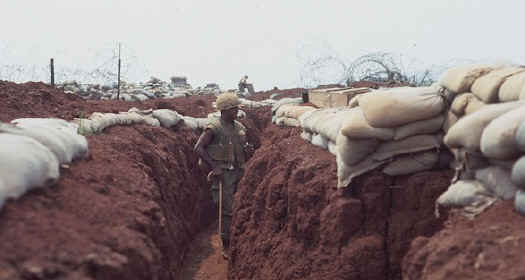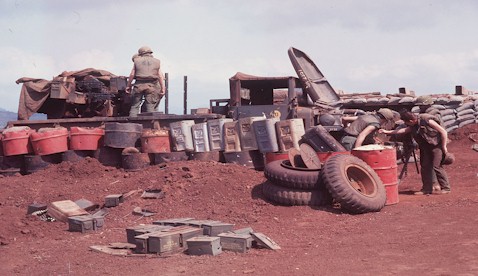My worst experience came on the evening of March 22, 1968. It had been rumored for weeks that the NVA would launch a ground assault against the base to coincide with the anniversary of the March 1954 assault on the French stronghold at Dien Bien Phu. At about 2100 hours the NVA began an intense artillery, rocket and mortar barrage. The concentration of incoming artillery and mortar rounds was the heaviest I had ever experienced, and we feared that the NVA would launch a ground assault under the cover of this barrage.
The Marines were slow to dig in, but trenches gradually connected firing positions and offered protection from NVA snipers, mortars, rockets and artillery.
The sergeant and I were pinned down in our bunker by incoming rounds. For a short time we maintained landline communications with our gun positions, but the landline was broken shortly thereafter. The barrage continued, and I decided to try to make a dash for the trenchline about 25 meters in front of us to check out the gun positions. I crouched in the doorway of the bunker, frozen in fear as the rounds exploded all around us. It seemed like an eternity as I waited for a lull in order to make my move.Finally I couldn't wait any longer and took off for the Quad 50 position with the sergeant right at my heels. When we got to the bunker, we found the crew huddled inside unable to make contact by landline or radio with the other gun positions. It was critical that we coordinate our fire missions in the event of a ground assault on our sector of the perimeter. After alerting the crew of the Quad 50 to standby to man their guns, I decided to send the sergeant to the nearby Duster position with similar orders. I then began to make my way along the trenchline in the opposite direction to the distant Duster and Quad 50 positions at the other end of the runway.
I got no more than a few meters when a rocket crashed into the Charlie Company, 1/26 Marines, command post bunker about 50 meters in front of me. I raced to the bunker where I found several Marines frantically digging in the burning debris to pull out their comrades trapped inside. They had retrieved a few men, but several others were buried inside the collapsed bunker.
We called for a corpsmen to treat the survivors who were badly burned and wounded, but none heard us amidst the incoming and the confusion. Without medical intervention these men would certainly die, so I made the decision to run across the runway to retrieve medical help from "Charlie Med." I climbed out of the trenchline and ran for the runway. In the darkness I tripped and fell several times as rounds shook the ground around me. I finally made it to the runway and across in the direction of "Charlie Med". As I got closer I screamed for a corpsmen, and a young Navy corpsmen ran toward me from his bunker. He and another Marine followed me back across the runway to the burning bunker where they began administering aid to the wounded.
Leaving the demolished bunker, I made my way down the trenchline to the Quad 50 and Duster positions, where I found my squad leader, Sergeant Manuel Floyd Martinez, and both crews safe and ready to man their guns. We traced the landline back to a break in the wire that we quickly repaired so we could regain communications with all of our other gun positions.
Shortly after midnight and some 1,109 rounds after the NVA barrage had begun, it was over. This would be recorded as the second heaviest saturation of enemy rounds in a single day during the siege, and the heaviest for the month of March. It took a very heavy toll on Charlie Company, 1/26 Marines, with whom my men and I lived and shared the defense of our sector. I later found out that five Marines died in the command post bunker that night, including Captain Walter J. Egger, Gunnery Sergeant John J. Grohman, First Lieutenant Paul W. Bush, Lance Corporal Stephen C. Shannon, and Private First Class Bennie J. Sisson.
Our truck-mounted Quad 50 crewmen check out an engine block that was zapped by a near direct hit by an NVA rocket.
I had come to know and admire Captain Egger. He had only been in country one month, having arrived at Khe Sanh about the same time as myself. Although I was thankful that my men and I survived that night with no casualties, it would surely impact some of our lives for many years to come. I am very proud of the Bronze Star with "V" Device that I received for my actions that night, but I did no more than anyone I knew would have done under the same circumstances. The heavy fighting continued for another week or so, but by the last week in March the incoming wound down considerably.

